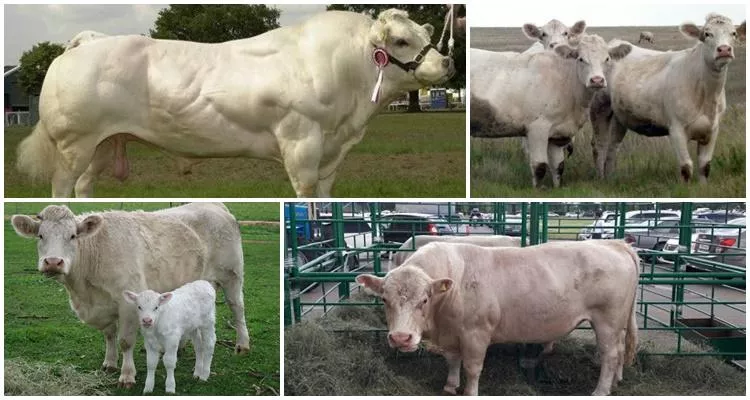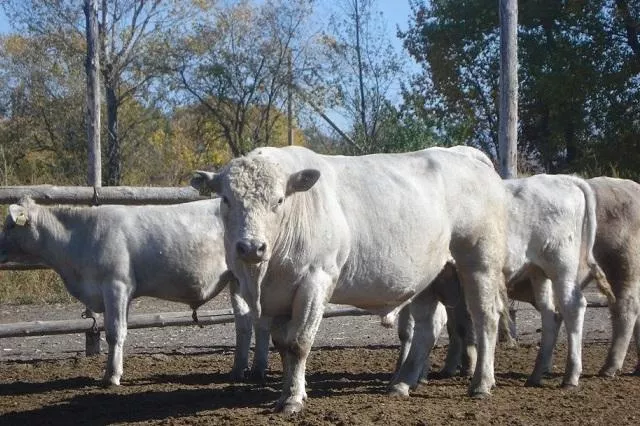Auliekol breed of cattle: description and characteristics, rules of keeping
Despite the presence of numerous breeds of cows, their selection does not stop. In modern animal husbandry, new breeds with promising characteristics are emerging. Consider the description and characteristics of the Auliekol breed of cattle, its requirements for care and maintenance, diet, features of keeping, diseases that animals in the household can suffer from.
Description and characteristics of the Auliekol cattle breed
The breed was bred in 1992 in Kazakhstan. Cows were selected from the offspring of 3 breeds - Angus, Charolais and white-headed Kazakh. Auliekolskaya variety - meat orientation, as well as the breed from which it was derived.The main valuable features of the new breed are precocity, high weight, ease of childbirth.
The meat of Auliekol animals is similar in taste and characteristics to the meat of the Angus breed - the so-called marble, when fat forms thin layers near the muscle tissue. The light gray color and precocity of the cow are inherited from the Angus.
Bulls and cows are muscular, massive, with strong bones. They have a large head on a short neck, 70% of individuals do not have horns. Height at the withers - 140 cm in males, in females - 130 cm. The coat of Auliekol cows is short and thick. The weight of females is 700-900 kg, males - 1-1.2 tons. The weight of calves at birth is 25 kg, the daily gain is 1.5 kg for heifers, 1.7 kg for bulls. By the age of 15 months, they already weigh 540 kg. For 1 kg of growth, they spend 6 feed. units Slaughter yield of meat - 60-63%.
The high meat productivity of the breed does not reduce its milk productivity. After 3 calving, the female can give 20 liters of milk.
Animals are he althy, with good immunity, hardy, quickly adapt to different climates, tolerate temperature changes and weather changes well. By winter they are overgrown with wool.
Pros and cons
The disadvantage of the Auliekol breed of cattle is that the breeding stock is still small, and it is difficult to acquire a thoroughbred calf or an adult animal.
Maintenance and care requirements
In the barn, each individual should have at least 2.5 per 2 m of area.The room may not be insulated, but it must be protected from drafts. For ventilation, it is necessary to provide a special exhaust system or equip windows with vents. Floors should be sloping, with slurry draining towards the back wall. It is desirable that with a large number of livestock, the distribution of feed, water and manure removal should be automated. Every day, cows need to be cleaned and the dirtiest places on the skin should be washed. Cleaning and massage contribute to the improvement of the physical and mental condition of the cattle.
Young and adult Auliekol cows are walked every day if they are kept in stalls. But pasture content is considered the most optimal. Animals do not suffer from cold and heat. From spring to autumn, they can be kept in the wild, under light sheds.

Meeting plan
Calves are kept not with their mothers, but in special boxes with warm bedding. Until 3 weeks of age, they eat whole milk, up to 6 times a day.In 1 month, in addition to 4 liters of milk, the calf should receive 2 liters of milk. At this age, he can be accustomed to hay, give oatmeal jelly. At 3 months, you can give vegetables, every 1.5 weeks their volume is increased by 200 g. Chalk and s alt are added to the feed. Then dry food and silage are introduced into the diet of cows. From 5 months, grass, hay and root crops become the basis of the diet. Vegetables and tubers should be chopped to a size that is comfortable for small animals.
A six-month-old calf can eat 3 kg of grass and 5 kg of vegetables and drink up to 2-3 buckets of water. The liquid should be warm - in the cold season, in the warm - cool. After weaning, the young are transferred to the herd.
Adult cows are fed grass on pasture. They graze in one place until they eat all the grass that is there. They eat coarse vegetation, which is not to the taste of animals of other species. In addition to grass, they are fed with hay, silage, vegetables, root crops. Give them s alt and chalk. You can feed with compound feed, partially or completely.Milking animals should receive at least 60 kg of feed per day. The appetite of Auliekol cows is good, with poor nutrition they begin to gnaw on wooden parts in the stalls.
Breeding
To get purebred animals, only purebred cows and bulls need to happen. But, since the population of the Auliekol breed is still small, it is possible to get crossbreeds with other breeds of cattle. In this case, aulie-rings are considered to be improvers, both when crossed with outbred animals and purebred ones, they give offspring with characteristic valuable qualities. Calves inherit precocity, rapid growth, marbled meat.
Possible diseases
There are no special diseases that mainly affect the Aulie rings. Cows can suffer from infectious and gastrointestinal diseases, but only if the rules for keeping and feeding are not followed.
To prevent infectious pathologies, cattle are vaccinated according to the same scheme as animals of other varieties. To maintain he alth, it is necessary to keep the barn clean, feed the cows only with high-quality food and drink clean water, change the bedding, clean the feeders from food residues.
The Auliekol breed of cattle is not even 30 years old, but, despite its youth, it has great prospects. Possessing the most valuable qualities of charolais and angus, they are unpretentious, indiscriminate in food, resistant to diseases and peculiarities of various climates. The cattle is suitable for meat growing and breeding in any region of Russia, both in private homes and industrial farms.
Recommended
Hereford breed: description and characteristics of cattle, keeping and breeding

Hereford cows were bred in the 18th century. Known for endurance, unpretentiousness, large body weight and high quality meat of the marble variety.
Padua chickens: description and characteristics of the breed, rules of keeping and care

Paduan chickens have an unusual appearance and are very popular with fans of decorative birds. To achieve success in their cultivation, it is worth considering a number of features.
Aurora: breed of chickens, description and characteristics, rules for keeping and care

Aurora chicken breed is considered quite popular. To achieve success in its cultivation, it is worth providing the birds with optimal conditions and feeding them properly.







